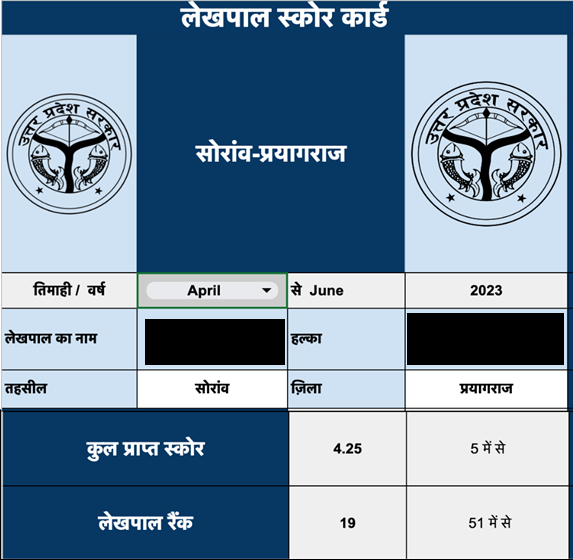In rural parts of India, Lekhpals or patwaris play an important role in upholding property rights by maintaining land records – however, there is no effective system to track their performance. In this note, Sarthak Agrawal describes the implementation of LAKSHYAM, a system for holistic assessment and management of Lekhpals, in his tehsil, Soraon, in Uttar Pradesh. He describes the system design, and the effect providing incentives had on worker outcomes, revenue board performance, and accountability.
Lekhpals, also known as patwaris, are government servants who maintain village revenue accounts and land records, and play a vital role in upholding property rights in rural areas. They help in demarcating land boundaries, settling land disputes, ensuring public land is free of encroachments, and processing several important applications, such as for income and caste certificates. Since these are precisely the matters that rural citizens care about the most, and raise most often in public meetings with bureaucrats and elected representatives, the work of Lekhpals is crucial for shaping the public’s perceptions of the state.
Despite the importance of Lekhpals’ work for the functioning of the state, there is no objective performance management system to track their performance. This hinders the government’s ability to identify and reward strong performers, and to offer support and training to those who need improvement in specific dimensions. Although several scheme-level portals measure performance at different administrative levels (district, block, tehsil, and village), they fall short of providing a comprehensive evaluation of individual employees. Consequently, employees' assessments rely on arbitrary criteria, leading to ad-hoc and subjective evaluations. Moreover, although Lekhpals and other officials face upward vertical accountability to their superiors, they are insufficiently accountable to citizens or to independently defined standards of performance (Kapur et al. 2018). This lack of downward accountability adversely affects the department’s overall performance and service delivery.
Creating a system of performance management for Lekhpals
To address this challenge, the Prayagraj district administration joined forces with IDinsight and the Bill & Melinda Gates Foundation (BMGF) to create ‘LAKSHYAM’ - the Lekhpals' Actionable KPI System for Holistic Assessment and Management. Through LAKSHYAM, various data systems were integrated to assess a Lekhpal's performance across all their tasks, bolstered by 360-degree feedback on their work. While objective performance management based on key performance indicators (KPIs) is being contemplated in the government for employees with well-defined, specialised roles (for example, auxiliary nurse midwives), establishing KPIs for 'generalist' public sector workers like Lekhpals – who have to perform a wide variety of tasks – has so far been challenging. This is the gap that LAKSHYAM seeks to bridge.
The process began by compiling a comprehensive list of services delivered by the Lekhpals to citizens and other government departments. This list included over 30 distinct items. We carefully selected a subset of permanent tasks that form the core of their regular responsibilities to create a performance management system, which consists of three key components:
i) Objective parameters: Major workstreams within the revenue department were mapped, and KPIs were developed to measure Lekhpals’ performance in each dimension. The indicators can be assessed using the department's existing digital data systems as well as the physical registers maintained by the tehsil and revenue court. In some cases, the team designed new templates for the physical registers, so that aspects of individual performance could be more easily measured. These KPIs focus on activities within a Lekhpal's control, such as the timely submission of investigation reports, rather than outcomes that may require support from other team members.
ii) Supervisor feedback: To capture subjective feedback, Lekhpals' immediate supervisors (Revenue Inspectors) were surveyed and asked to rate each Lekhpal who reported to them on six key competencies: technical knowledge, internal communication, external communication, responsiveness, ownership of work, and time management.
Rubrics were developed for each competency in Hindi, and supervisors received comprehensive training on how to conduct these evaluations. In the future, technical knowledge can also be assessed through customised proctored assessments.
iii) 360-degree feedback: Feedback on Lekhpals’ performance quality was also collected from their colleagues, peers, and officials such as the Registrar Kanungo, Naib Tehsildar, and Data Entry Operators who routinely interact with Lekhpals in their professional and personal capacities. Competencies assessed under 360-degree feedback include responsiveness, politeness, positive attitude, knowledge, and adherence to systems and protocols.
Figure 1. An example of a Lekhpal performance review score card

Note: Scores are out of 5 for each component, and a weighted average is computed – 50% for KPI scores, 30% for supervisor feedback, and 20% for 360-degree feedback.
We also plan to survey citizens who have interfaced with Lekhpals to ask them objective questions about their interaction. We have designed protocols for regular citizen surveys, which emphasize objective attributes to minimise subjectivity and build credibility for the new performance management tools. For example, citizens will be asked whether the Lekhpal assigned to their case spoke to them over the phone or visited their village before submitting the report. This approach will likely foster greater accountability within the revenue department towards citizens.
Implementing LAKSHYAM in Uttar Pradesh
This system has been successfully introduced and implemented in the Soraon tehsil of Prayagraj, in which I was serving as the Sub-Divisional Officer. Two rounds of performance assessment have been conducted in the tehsil, with subsequent evaluations scheduled every quarter. These resulted in a rank-based scorecard for all Lekhpals in the tehsil, which were aligned closely with senior officers’ subjective perceptions of performance. The best performing Lekhpals were felicitated on Independence Day (15 August) and Gandhi Jayanti (2 October), and they reported immense satisfaction at being publicly acknowledged in this manner by senior officers. We are already seeing some improvements in outcomes that have coincided with the rollout of LAKSHYAM. For instance, over the past few months Lekhpals have become quicker in processing citizens’ grievances.
As more tehsils and districts adopt a performance management system similar to LAKSHYAM – a second tehsil, Bara, has since implemented LAKSHYAM and completed one round of performance assessment – all Lekhpals across Uttar Pradesh can be ranked using the system. The UP Board of Revenue can then leverage various tools to publicly acknowledge and encourage top performers, as well as assist poorer performers to improve. While not all personnel-based decisions may strictly adhere to these performance management results, the Lekhpal leaderboard and Lekhpal-wise scorecards can serve as a valuable starting point for senior officials to objectively understand their team members' capabilities.
With the establishment of credibility and buy-in for LAKSHYAM within UP's revenue system, the same system could also be employed to conduct performance reviews at higher levels by pooling the performance of those working under their supervision. For instance, a Revenue Inspector's performance could be the average performance of all Lekhpals operating under their supervision. Similarly, a Sub-Divisional Officer’s performance can be evaluated using the same approach.
Conclusion
The ultimate objective of this initiative is to shift from a culture of continuous negative feedback to one relying on constructive feedback. Instead of merely reprimanding employees for poor performance, such systems can enable senior officers to identify the underlying reasons for underperformance and provide support to help Lekhpals overcome the challenges that they face while performing their job. Where employees display a lack of diligence, appropriate disciplinary measures are available to address such issues, but we hope that well-performing employees will find ample incentives to excel within the new system.
In summary, by integrating multiple data systems and introducing objective parameters, supervisor feedback, and 360-degree feedback, LAKSHYAM provides a comprehensive and transparent assessment of individual employees' performance. As the system expands across Uttar Pradesh, it has the potential to transform personnel-based decisions, encourage constructive feedback, rewarding excellence, and promote downward accountability. This will ultimately result in a more efficient and effective revenue workforce as envisaged under Government of India’s ambitious Mission Karmayogi, the National Programme for Civil Services Capacity Building.
Further Reading
- Kapur, D, PB Mehta and M Vaishnav (2018), Rethinking Public Institutions in India, Oxford University Press.




 07 November, 2023
07 November, 2023 




Comments will be held for moderation. Your contact information will not be made public.